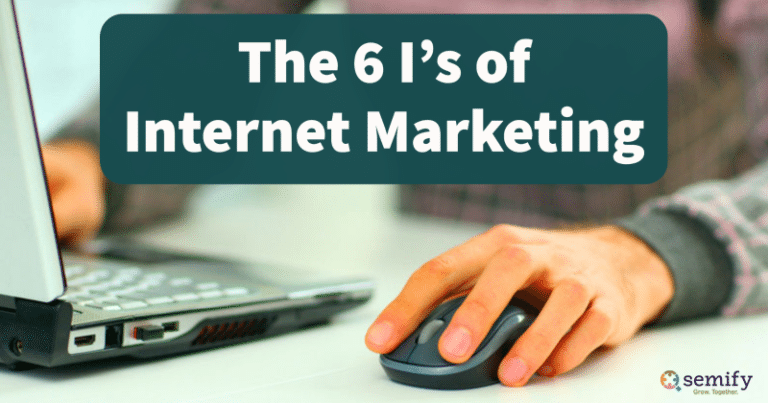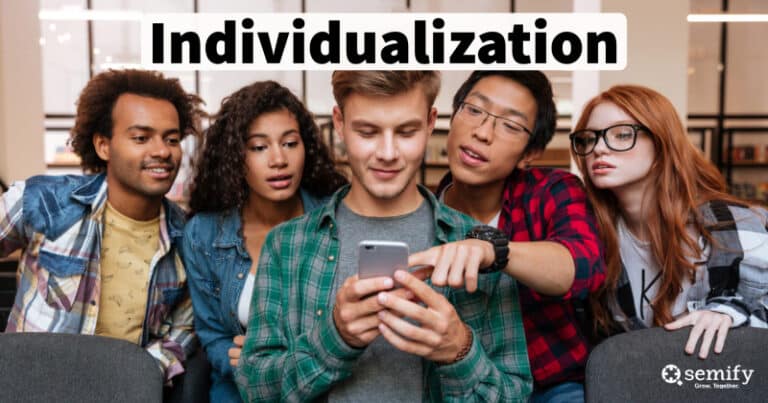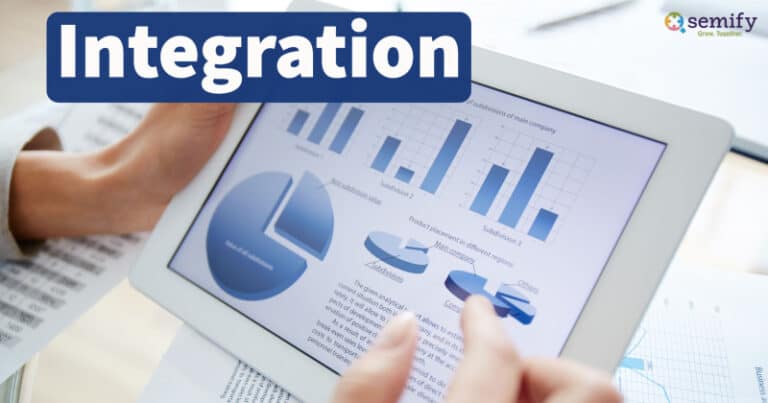
We all know that internet marketing has been a game-changer. This ever-evolving field has enabled business owners to reach global audiences like never before.
But because digital marketing changes so rapidly, it can often be tough to keep up.
Fortunately, there are a few factors that remain relatively constant, despite the constant innovation. And while internet marketing is impacted by innovation, there are six other “I” words that set this sector apart.
We like to call these the 6 I’s of Internet Marketing.
They include:
In this post, we’ll discuss each of these values and why they matter when developing any online marketing strategy. Without further ado, let’s talk about the 6 I’s of Internet Marketing!

Interactivity
The power of the internet allows consumers to interact with marketing collateral.
Interactivity starts with the ads themselves. For example, Google pioneered TrueView ads in YouTube. TrueView ads allow the user the option to skip a video ad after watching 5 seconds. Advertisers only pay for ads that are not skipped.
This level of interactivity provides benefits to both the advertiser and the audience. For the advertiser, their ad buys become more efficient and they get a feedback loop about the effectiveness of their creation. For the audience, they make the decision about the ads that are interesting and presumably will be served more ads that meet their interests.
This video-based phenomenon on platforms like YouTube and Facebook has opened up other interactive options. Facebook users can engage with ads by liking the publisher and even commenting on the ad and responding to friends or strangers. This type of interaction and engagement was never possible with mediums like TV, radio, or print advertising.
In addition to ads, advertisers can now invest in one-to-one post-click experiences. Many advertisers will create landing pages that directly relate to the ad that was displayed. This can take the user directly to a product page that explains the particular product or a service page with relevant testimonials.
In the traditional print world, there was often friction in finding the specific product or service being advertised. Now, it’s easier than ever to guide the customer to what they’re searching for.
Don’t forget that interactivity is actually a ranking signal referenced by Google. Interactivity delays on a website can impede your ability to rank well in search results. To get the most out of your marketing, make sure to remember the Core Web Vitals (including those that pertain to interactivity!).
Interactivity can also be seen in tools like polls and surveys, which are regularly implemented as part of a strategy to engage with consumers. Email marketing is becoming increasingly more interactive, as well, which can often help brands stand out from the crowd.

Intelligence
The second of the 6 I’s of marketing online is intelligence. Due to the fact that extensive market research is conducted in a cost-effective manner, intelligence is an inherent aspect of internet marketing.
Customers rely on the internet to provide them with the answers they seek. In turn, the internet also provides information about consumers and companies are able to gather this information to use for their benefit.
Specifically, artificial intelligence, automation, and programmatic ads can make digital marketing far more effective without removing the human elements to which consumers want to connect.
Artificial Intelligence
AI might sound like a scary concept, but marketers have been using it to great effect in recent years. That’s why we’ve included it under the category of intelligence in our 6 I’s of digital marketing.
Artificial intelligence is now utilized to provide everything from content creation to customer service. AI makes it possible to serve more personalized recommendations, analyze customer behavior, predict trends, test theories, chat with customers, increase email open rates, and essentially streamline processes that would otherwise take far longer to implement.
While there’s no replacement for real human interaction, AI can help brands speed up processes, eliminate redundancies, and make better decisions about their marketing strategies. Using AI tools can free up resources and help your team use their skills more efficiently. They can even reduce errors and eliminate monotonous tasks.
Automation
Automation often goes hand-in-hand with AI, but it’s often seen as a more approachable concept. Being able to automate processes that used to be executed on a manual basis can ensure consistency while eliminating wasted time and resources.
You can easily automate email sequences and drip campaigns, lead generation, order updates, and even social media management. You can rely on the skills of your team or an outside vendor to create the initial content or perimeters of the task before relying on automation software or other platforms to actually execute the job.
This can reduce time spent on these crucial marketing efforts (and actually eliminate delays and other human errors) by automating where appropriate.
Programmatic Advertising
Programmatic advertising is based on user-level data aggregated from first- and third-party sources. Larger advertisers are able to use the behavior of their current customers to find “similar to” or “lookalike” audiences.
Programmatic advertising is powered by the rise of Big Data. Agencies and large advertisers are assembling data troves from multiple sources to make their targeting even more efficient.
In the golden years of traditional advertising, advertisers focused on Nielsen or other audience measurement providers to roughly match their prospect to the type of TV or radio they consumed. This targeting was typically limited to attributes like age, gender, income, and some very basic psychographic characteristics.
But the intelligence offered by Big Data and programmatic has drastically increased the number of targeting options available today. While some platforms like Facebook have been forced to cut back on the amount of personal information shared with advertisers, programmatic ad buying is still an incredibly important part of digital marketing in the modern age.
The easiest way to explain programmatic is the use of software to purchase digital ads. Traditionally, you’d have to waste time putting in manual bids and negotiating terms with publishers. But now, you can use an algorithm-powered software system to buy and sell online advertising space.
One of the benefits of programmatic is that it can often lead to a better return on investment for advertisers. Because this software uses more sophisticated means of targeting to determine ad placements, you may receive more impressions (and subsequently see more successful campaign growth) by using programmatic ads. And because the process isn’t completely automated, you can utilize the skills of your team to optimize ads as needed, rather than devoting those resources to the buying and selling process.

Individualization
Advertisements and other online marketing activities can be customized to an individual’s location, demographic, age, gender, interests, and more. The ability to target a certain demographic or geographic area is also how internet marketing excels in individualization.
Personalization is too important to be ignored, which is why this has to be included when we explain the 6 I’s of digital media and marketing. Here are just a few examples of individualization at work.
Retargeting
The individualization of digital marketing provides the best chance for a marketer to cut through the clutter of digital ads.
Perhaps one of the best illustrations of this can be found in retargeting ads. If you’ve ever looked at a website and felt like you were being followed by that brand’s products around the internet… it’s not a coincidence. You’ve been retargeted.
Advertisers can code their website to automatically generate ads based on the browsing history or specific actions performed by a visitor. This type of retargeting is known as pixel-based, or cookie-based, retargeting.
E-commerce websites, for example, will use browsing history to automatically generate ads that show items that a consumer recently viewed on their website. Advertisers can increase their ROI by leading people back to a shopping cart pre-populated with the products that customer viewed. These ads reduce the friction in completing transactions.
Search Intent
Advertising platforms develop rich profiles of the consumer and then enable advertisers to use this information to better target ads. Google Adwords has generated billions in revenue for Google. Advertisers see large ROI because Google allows advertisers to tap into “in market” events triggered by what people are searching.
When someone searches for an “emergency plumber in Atlanta,” advertisers can read into that search query to understand:
- where the person needs the service
- when they need it (immediately!) and
- the type of service
Ad platforms can also provide the advertiser information about the specific location of the person searching, demographic information, and even if they’d previously visited the advertiser’s website.
Understanding the intent of a given internet user can reveal a wealth of information for brands. It goes beyond search volume or number of impressions; instead, it reveals the motivation of the web user, which can be crucial information when trying to sell products or services at specific points in the buyer’s journey.

Integration
The integration of traditional and online marketing methods (such as a billboard or magazine ad featuring a QR code) is a concept that continues to evolve and intrigue marketers. Combining different media channels via internet marketing also allows interactivity and intelligence to meet. Subsequently, integration had to be included in our post about the 6 I’s of internet marketing.
The Impact of Big Data
As marketers became empowered to collect richer customer profiles, a new segment of software began to emerge. Modern marketers rely on automation platforms for both B2C and B2B brand promotion.
Marketing automation platforms are part data warehouse, part email marketing, and part reporting. There has always been a continuum of analytical to creative skills required in marketing roles, but the internet has moved the data geeks from the back room to the front lines.
Marketing automation allows marketers to understand and expand on the journeys customers take in an effort to educate pre-purchase and provide post-purchase support.
In addition to marketing automation, consumers expect unified experiences across devices and channels. Let’s take the example of Domino’s Pizza. In 2017, the company offered 15 different channels that customers could use to place an order. The name of the game for marketers is to be where their customer is and make the user experience seamless between channels.
Siloed operations would never be accepted today, which means information needs to be shared consistently and in real-time across a brand’s various platforms. Big Data allows us to do just that while fully integrating the customer experience and helping marketers reach those customers more effectively.

Industry Restructuring
Digital marketing has disrupted processes that businesses used for decades. It’s been particularly problematic for the “middle men.”
Travel agents, local retailers, brokers, cab companies, and others have struggled with the rising popularity of online marketing. Customers would rather use direct booking and ordering when possible, so it’s no surprise that more efficient intermediaries operate more successfully in our digital world.
That’s not to say that brands can’t adapt, however. They may just need to embrace the needs of today’s customer and pivot to meet their expectations.
In fact, our customers can actually be considered “the middle men” of the digital marketing industry. We don’t work directly with small business owners; instead, we work with white label resellers.
When you have the right infrastructure in place and are able to target the right customers, you can thrive in the B2B space. But keep in mind that what once worked for you in terms of marketing and advertising may have shifted rapidly in recent years.

Independence of Location
Being able to market a product or service from a personal computer at home is a great advantage of internet marketing, particularly during a global pandemic. The same can be said for the ability to be reached as a consumer from anywhere with a Wifi connection.
Undeniably, digital marketing has a number of benefits over traditional marketing. Among them are accountability, testing, flexibility, micro-targeting, and cost-control. All of these aspects combined can help you run a successful online marketing campaign.
Independence of location ties back to data and targeting. Rather than targeting people in monolithic blocks based on the shows they watch or the zip code in which they reside, the internet can assist you in reaching customers based on much richer profiles of what they are interested in and what they need at a particular time.
For example, say your ideal customer is planning a vacation. They might be targeted while researching and planning their trip, but they may also need help later on with making reservations or accessing tickets to events.
With that in mind, sites like Tripadvisor will change their content based on the customer profile that was created. Tripadvisor knows when you plan to travel, as well as when a customer is likely to book hotels, tours, and other attractions leading up to the trip. As a result, Tripadvisor will tailor their emails to fit this timeline and will even continue to email the customer during their trip.
This is a level of marketing and targeting that would be impossible to achieve with traditional marketing in the offline world. Having the ability to reach customers at virtually any time, anywhere is a huge boon to marketers while allowing consumers to interact with brands outside of traditional business hours and in ways they never thought possible.
Why the 6 I’s of Internet Marketing Matter
Now that you understand what the six I’s of digital marketing are, you may be wondering why they’re so important.
Keeping these factors in mind can help you run more effective campaigns for your clients. They can also empower you to convince prospects that they need digital marketing services in order to compete in 2022 and beyond.
Because the digital arena evolves so quickly, keeping track of the newest developments in these areas can make you a more successful marketer. What’s more, understanding their relevance can help you choose the right fulfillment partners to grow your business. And in the end, that’s what we want for you.
Of course, you don’t have to become an expert in how digital marketing will continue to change for your clients. To learn more about how our white label SEO reseller program can help ease that burden for your agency, get in touch with us today.